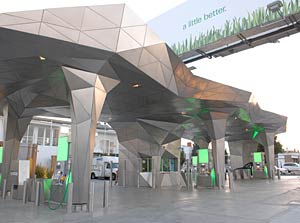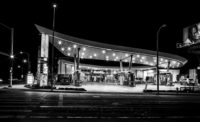As gasoline prices speed toward the $4-per-gallon mark, consumers are buying hybrid and flex-fuel cars or filling up with biodiesel, and new ethanol plants are sprouting up to squeeze an alternative fuel from corn. Fittingly, the retailers of these cleaner fuels are using green design to make an architectural statement that their pit stops are as ecoconscious as their fuels.


Photo © Tomas Endicott (top); Courtesy BP (above).
The roof of SeQuential Biofuels, in Eugene, Oregon, is planted with native shrubs. Pump islands are sheltered by photovoltaic panels, which generate electricity for the building (top). Helios House in Los Angeles also features photovoltaic cells embedded in its roof, as well as a rainwater capture system (above).
In Eugene, Oregon, SeQuential Biofuels opened the state’s first commercial biofuel facility last year. The station dispenses ethanol as well as locally sourced biodiesel. Company cofounder Ian Hill worked with his mother, Susan Hill, AIA, an architect based in Lexington, Kentucky, to incorporate green features into the station’s design. A roof embedded with a 32.6-kilowatt photovoltaic array shelters the pump islands; its central panels have clear backings to transmit more daylight. The roof above an accompanying 2,000-square-foot convenience store also received a green treatment: It is planted 5 inches deep with 4,800 native Oregonian plants. Bioswales adjacent to the parking areas filter storm water.
Alan Eliot Goldberg, FAIA, a former design consultant to ExxonMobil, has developed a prototype station that embraces sustainable materials as well as solar power, which is used to create hydrogen fuel via electrolysis. Adapted from his Advanced Refueling Retail Center concept, it dispenses six different kinds of fuel. The 5,000-square-foot station will include a convenience store and an information center for hydrogen power. “If you’re introducing a new product, you should have a new concept,” Goldberg says of its design. Developed by the ARRC/H2 Alliance, the first station is planned for Syracuse, New York.
Will the green principles adopted by this small group infiltrate America’s massive network of gas stations? BP may have the answer with its Helios House demonstration project, designed by Office dA with Johnston Marklee. Located on a 10,530-square-foot site in Los Angeles, it produces energy via photovoltaics, captures rainwater for irrigation, and reduces the urban heat island effect with a drought-tolerant green roof. Ironically, although these green features make the station eligible for a LEED Gold rating, Helios still dispenses old-fashioned gasoline. At least it’s a start.





Post a comment to this article
Report Abusive Comment